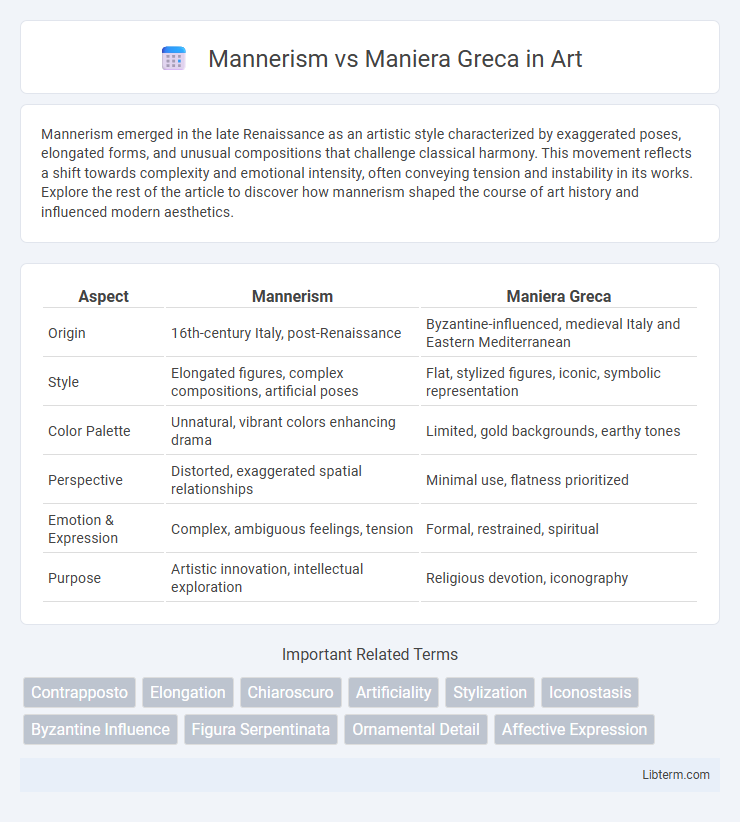Mannerism emerged in the late Renaissance as an artistic style characterized by exaggerated poses, elongated forms, and unusual compositions that challenge classical harmony. This movement reflects a shift towards complexity and emotional intensity, often conveying tension and instability in its works. Explore the rest of the article to discover how mannerism shaped the course of art history and influenced modern aesthetics.
Table of Comparison
| Aspect | Mannerism | Maniera Greca |
|---|---|---|
| Origin | 16th-century Italy, post-Renaissance | Byzantine-influenced, medieval Italy and Eastern Mediterranean |
| Style | Elongated figures, complex compositions, artificial poses | Flat, stylized figures, iconic, symbolic representation |
| Color Palette | Unnatural, vibrant colors enhancing drama | Limited, gold backgrounds, earthy tones |
| Perspective | Distorted, exaggerated spatial relationships | Minimal use, flatness prioritized |
| Emotion & Expression | Complex, ambiguous feelings, tension | Formal, restrained, spiritual |
| Purpose | Artistic innovation, intellectual exploration | Religious devotion, iconography |
Introduction to Mannerism and Maniera Greca
Mannerism, emerging in the late Renaissance during the 16th century, emphasizes elongated forms, exaggerated poses, and complex compositions to convey emotion and tension beyond naturalistic representation. Maniera Greca, prevalent in Byzantine and early Italian art before the Renaissance, features stylized, flat figures with gold backgrounds and a focus on spiritual symbolism rather than realistic perspective. Understanding the contrast between Mannerism's expressive distortion and Maniera Greca's iconic rigidity reveals key shifts in European artistic priorities and techniques.
Historical Context: Origins and Development
Mannerism emerged in the late Renaissance around the 1520s in Italy, characterized by elongated proportions, exaggerated poses, and complex compositions that deviated from Renaissance naturalism. Maniera Greca refers to the Byzantine-influenced style dominant in Italy before the Renaissance, marked by flat, gold backgrounds and stylized figures rooted in medieval iconography. The transition from Maniera Greca to Mannerism reflects a broader cultural shift from medieval religious art toward human-centered, expressive, and sophisticated aesthetics.
Defining Characteristics of Mannerism
Mannerism is characterized by elongated proportions, exaggerated poses, and a tension-filled composition that departs from the balanced harmony of the High Renaissance, emphasizing complexity and artificiality. It contrasts with Maniera Greca, which is rooted in Byzantine traditions featuring flat, symbolic, and highly stylized figures with gold backgrounds and a lack of perspective. Mannerism showcases sophisticated color palettes, ambiguous spatial relationships, and emotional intensity, reflecting a deliberate move toward artistic virtuosity and intellectual engagement.
Key Features of Maniera Greca Style
Maniera Greca style is characterized by its strong Byzantine influence, marked by flat, elongated figures and a lack of naturalistic perspective. It emphasizes gold backgrounds, stylized facial features, and frontal, static poses that convey spiritual symbolism rather than realism. This style contrasts with Mannerism's dynamic composition and exaggerated proportions, focusing instead on timeless, sacred iconography rooted in Eastern Orthodox tradition.
Influential Artists: Mannerism vs Maniera Greca
Mannerism, emerging in the late Renaissance, is characterized by artists like Parmigianino and El Greco, who emphasized elongated forms and exaggerated poses to convey emotion and complexity. Maniera Greca, rooted in Byzantine traditions, influenced artists such as Cimabue and Duccio, who prioritized stylized figures and gold backgrounds to evoke spiritual symbolism. The contrasting approaches highlight Mannerism's focus on individual expression versus Maniera Greca's adherence to iconographic conventions.
Artistic Techniques and Materials
Mannerism is characterized by elongated proportions, exaggerated poses, and complex compositions that create a sense of tension and elegance, often using oil paints on canvas to achieve vivid color contrasts and detailed textures. Maniera Greca, rooted in Byzantine tradition, relies on egg tempera on wooden panels, employing gold leaf backgrounds and stylized, flat figures with limited depth to emphasize spiritual symbolism. The contrasting use of techniques--Mannerism's dynamic brushwork versus Maniera Greca's meticulous, symbolic application--reflect distinct artistic intentions and material choices reflecting their cultural contexts.
Iconography and Symbolism in Both Styles
Mannerism showcases elongated figures and complex compositions, emphasizing stylized emotion and dynamic movement to convey spiritual tension, while Maniera Greca features rigid, frontal figures with gold backgrounds symbolizing divine light and eternal presence. Iconography in Mannerism often incorporates exaggerated gestures and ambiguous spatial relationships to express human drama, contrasting with Maniera Greca's strict adherence to Byzantine symbols like halos and hierarchical scales that communicate sacred authority. Symbolism in Mannerism is fluid and interpretative, reflecting Renaissance humanism, whereas Maniera Greca relies on established conventions to maintain theological clarity and devotion.
Regional Differences and Cultural Impact
Mannerism emerged in Italy during the 16th century, characterized by elongated figures and complex compositions reflecting a deliberate departure from Renaissance naturalism, primarily flourishing in regions like Florence and Rome. In contrast, Maniera Greca refers to the Byzantine-influenced style prevalent in Southern Italy and Sicily, featuring iconic, flat, and symbolic religious imagery rooted in Orthodox traditions. These regional differences shaped distinct cultural impacts: Mannerism influenced Western European art by challenging classical norms and inspiring emotional expressiveness, while Maniera Greca preserved Eastern Christian iconography, reinforcing Byzantine cultural identity in Southern Italy.
Legacy and Influence on Later Art Movements
Mannerism's legacy lies in its sophisticated distortions and exaggerated forms that influenced Baroque artists to explore emotional intensity and dynamic compositions, while Maniera Greca, characterized by its Byzantine stylization and flat, elongated figures, paved the way for the Italian Renaissance by bridging medieval iconography with naturalism. The dramatic expressiveness and complex spatial arrangements of Mannerism inspired later movements like Rococo and Romanticism to embrace theatrics and individualism. Maniera Greca's emphasis on symbolic representation and gold backgrounds left a lasting impact on religious art, contributing to the development of Western iconography and the transition towards realism in Renaissance painting.
Conclusion: Comparing Mannerism and Maniera Greca
Mannerism emphasizes sophisticated, elongated forms and complex compositions that challenge Renaissance balance, while Maniera Greca reflects Byzantine influences with its rigid, frontal figures and gold backgrounds. Artistic intent in Mannerism aims for emotional expression and artistic innovation, contrasting Maniera Greca's adherence to spiritual symbolism and tradition. Understanding these distinctions highlights the shift from medieval iconography to Renaissance experimentation in European art history.
Mannerism Infographic

 libterm.com
libterm.com